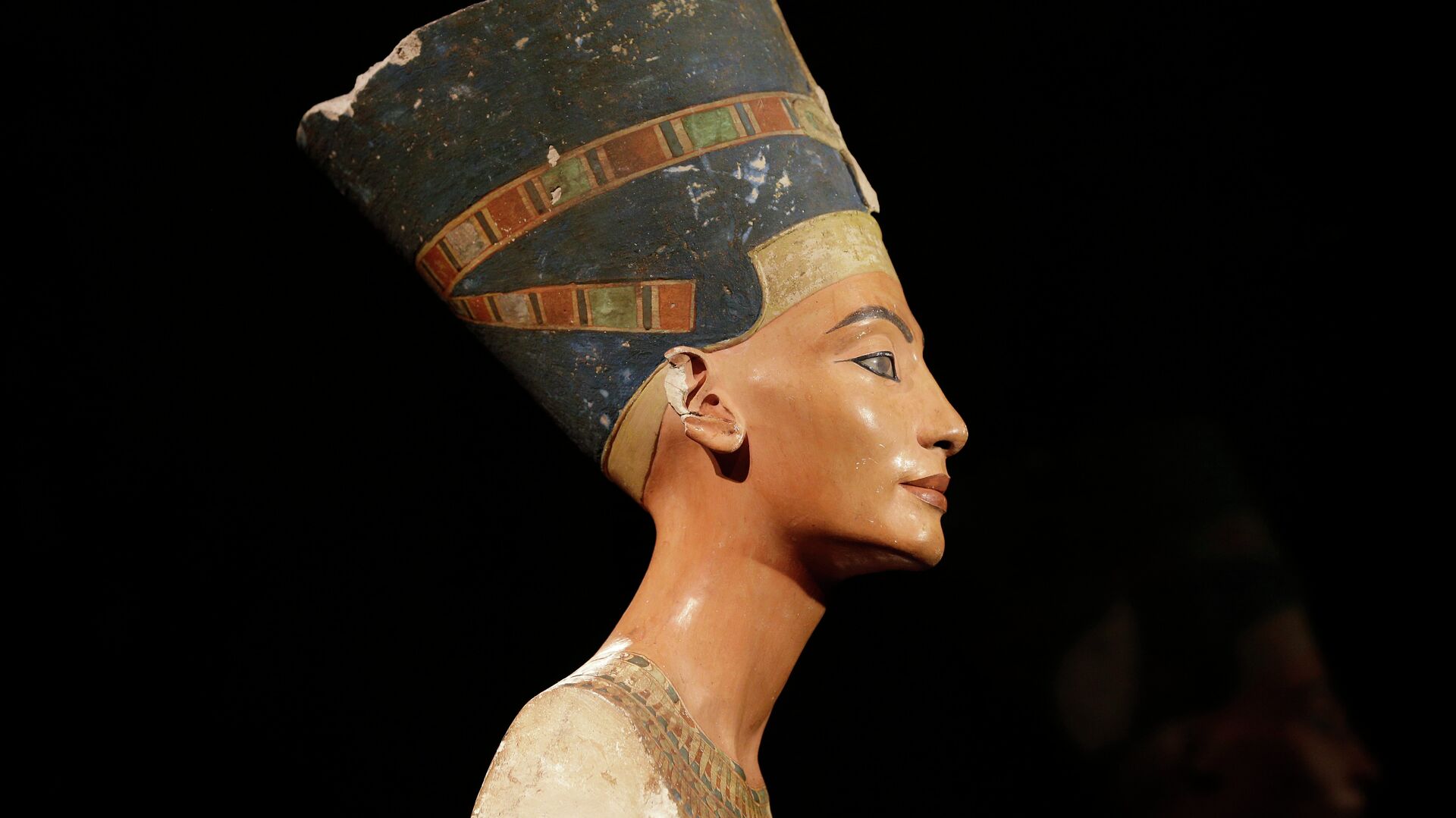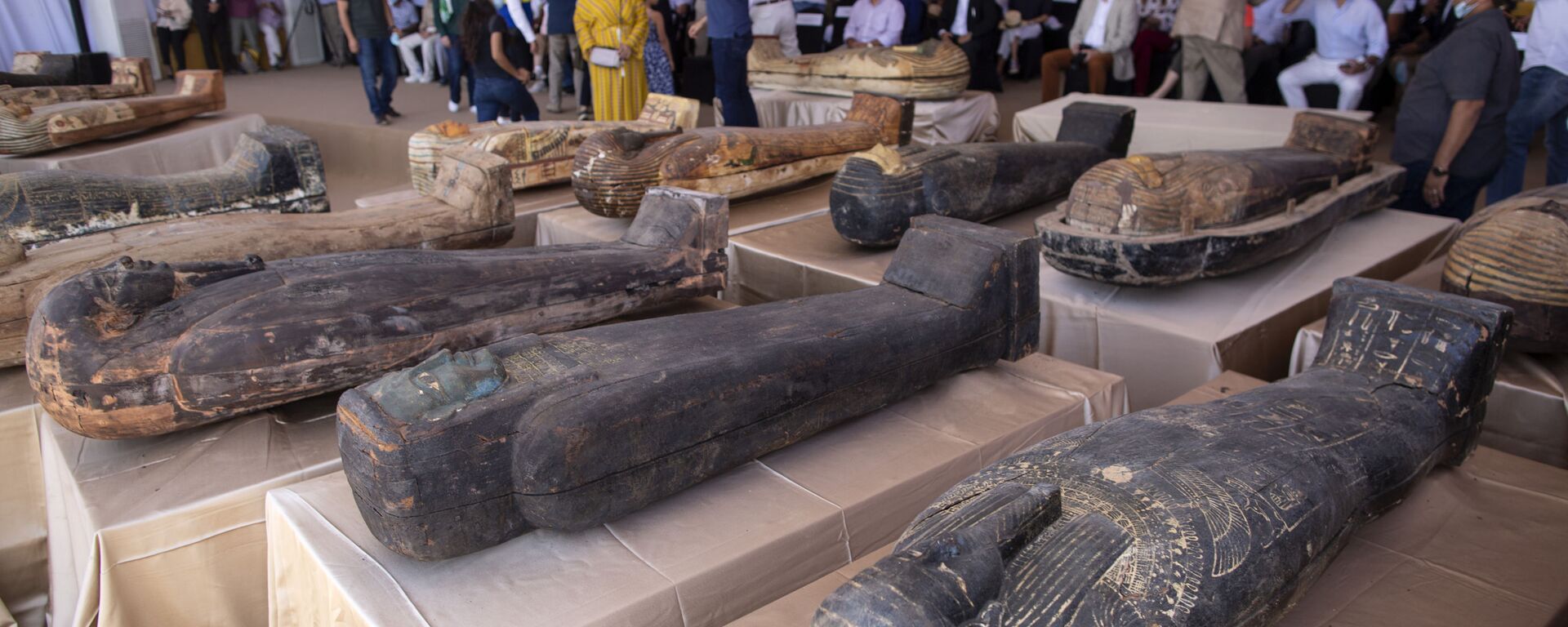https://sputnikglobe.com/20220916/egyptologist-close-to-identifying-nefertiti-who-may-have-ruled-egypt-1300-years-before-cleopatra-1100885400.html
Egyptologist Close to Identifying Nefertiti, Who May Have Ruled Egypt 1300 Years Before Cleopatra
Egyptologist Close to Identifying Nefertiti, Who May Have Ruled Egypt 1300 Years Before Cleopatra
Sputnik International
While ancient Egypt has been studied by modern archaeologists since the 1800s, it is estimated that only about 30% of artifacts present underground have been... 16.09.2022, Sputnik International
2022-09-16T22:02+0000
2022-09-16T22:02+0000
2022-09-16T22:02+0000
africa
egypt
egyptian mummy
queen nefertiti
ancient egypt
ancient history
https://cdn1.img.sputnikglobe.com/img/102566/31/1025663141_0:257:4932:3031_1920x0_80_0_0_cdf6abce90e13cd52c441a61168e08c2.jpg
Egyptologist Zahi Hawass believes he is close to proving that the body of a mummy first discovered in the 1800s is Queen Nefertiti, the wife of Pharaoh Akhenaten and mother of Tutankhamun, better known as King Tut. Nefertiti lived between roughly 1370 and 1330 BC.Hawass also believes that another mummy found in the same tomb is Ankhesenamun, the wife of Tutankhamun. He says he will be able to confirm his theory in October. Hawass is preparing an exhibition called “Daughters of the Nile” that will focus on the women of ancient Egypt during the pharaonic period.In addition to being the wife of Akhenaten and mother of Tutankhamun, many Egyptologists believe that Nefertiti ruled Egypt for a short time after the death of Akhenaten, though others disagree. If true, she would have taken the throne roughly 1300 years before Cleopatra.Hawass believes a mummy of a ten-year-old boy found in a different tomb (KV35) could be the brother of Tutankhamun and the son of Akhenaten. If that can be determined, then Hawass believes the mystery of Nefertiti will be solved.Both female mummies were found in a tomb named KV21. It was discovered in 1817 by prolific Italian explorer and early Egyptian archaeologist Giovanni Belzoni. It was later mapped by another famous early Egyptologist James Burton in 1825, who noted that it was well preserved and suffered no water damage.However, by the time the tomb was reinvestigated in 1989 during the Valley of the Kings project by Pacific Lutheran University, it had suffered significant damage. Water damage could be seen on the walls, indicating flooding. Bat guano was also present in the tombs, graffiti adorned the walls, and pieces of the mummies, which had been intact, were damaged and some parts were strewn across the room.In 1990, the tomb was secured with a steel gate, the mummies were reassembled as much as possible, and the valuables inside were put into protective coverings. In 1994, water entered the tomb again, but none of the objects inside were damaged.In the 2010s, Hawass started performing CT scanning and DNA analysis on the mummies, though initially they were not intact enough to determine their identities, only that they were from the 18th dynasty. Both mummies were found with their left arm over the chest, a pose reserved for queens.Akhenaten and Nefertiti sat on the Egyptian throne during a wealthy period in Egypt’s history that also saw a religious revolution spearheaded by Akhenaten and Nefertiti. Under Akhenaten’s rule, Egypt switched from being a polytheistic religion to a monotheistic religion that worshiped only the son god Aten. He also moved the capital city from Thebes to Amarna, possibly to weaken the power of the old priests. Those reforms were reversed shortly after Akhenaten’s death, either during Nefertiti’s theorized reign or early on in Tutankhamun’s reign as a child king.
https://sputnikglobe.com/20220531/egypt-displays-hundreds-of-newly-discovered-artefacts-dating-over-2500-years-old-1095887230.html
https://sputnikglobe.com/20220321/egypt-showcases-tombs-belonging-to-ancient-high-ranking-officials-1094051507.html
africa
egypt
Sputnik International
feedback@sputniknews.com
+74956456601
MIA „Rosiya Segodnya“
2022
News
en_EN
Sputnik International
feedback@sputniknews.com
+74956456601
MIA „Rosiya Segodnya“
Sputnik International
feedback@sputniknews.com
+74956456601
MIA „Rosiya Segodnya“
egypt, egyptian mummy, queen nefertiti, ancient egypt, ancient history
egypt, egyptian mummy, queen nefertiti, ancient egypt, ancient history
Egyptologist Close to Identifying Nefertiti, Who May Have Ruled Egypt 1300 Years Before Cleopatra
While ancient Egypt has been studied by modern archaeologists since the 1800s, it is estimated that only about 30% of artifacts present underground have been found. However, climate change, tourism, and the continued construction of modern Egypt are putting those artifacts at risk.
Egyptologist Zahi Hawass believes
he is close to proving that the body of a mummy first discovered in the 1800s is Queen Nefertiti, the wife of Pharaoh Akhenaten and mother of Tutankhamun, better known as King Tut. Nefertiti lived between roughly 1370 and 1330 BC.
“I’m sure I’ll reveal Nefertiti’s mummy in a month or two,” Hawass told Spanish newspaper El Independiente (via Newsweek) in an interview published on Tuesday.
Hawass also believes that another mummy found in the same tomb is Ankhesenamun, the wife of Tutankhamun. He says he will be able to confirm his theory in October. Hawass is preparing an exhibition called “Daughters of the Nile” that will focus on the women of ancient Egypt during the pharaonic period.
In addition to being the wife of Akhenaten and mother of Tutankhamun, many Egyptologists believe that Nefertiti ruled Egypt for a short time after the death of Akhenaten, though others disagree. If true, she would have taken the throne roughly 1300 years before Cleopatra.
Hawass believes a mummy of a ten-year-old boy found in a different tomb (KV35) could be the brother of Tutankhamun and the son of Akhenaten. If that can be determined, then Hawass believes the mystery of Nefertiti will be solved.
Both female mummies were found in a tomb named KV21. It
was discovered in 1817 by prolific Italian explorer and early Egyptian archaeologist Giovanni Belzoni. It was later mapped by another famous early Egyptologist James Burton in 1825, who noted that it was well preserved and suffered no water damage.
However, by the time the tomb was reinvestigated in 1989 during the Valley of the Kings project by Pacific Lutheran University, it had suffered significant damage. Water damage could be seen on the walls, indicating flooding. Bat guano was also present in the tombs, graffiti adorned the walls, and pieces of the mummies, which had been intact, were damaged and some parts were strewn across the room. In 1990, the tomb
was secured with a steel gate, the mummies were reassembled as much as possible, and the valuables inside were put into protective coverings. In 1994, water entered the tomb again, but none of the objects inside were damaged.
In the 2010s, Hawass started performing CT scanning and DNA analysis on the mummies, though initially they were not intact enough to determine their identities, only that they were from the 18th dynasty. Both mummies were found with their left arm over the chest, a pose reserved for queens.
Akhenaten and Nefertiti sat on the Egyptian throne during a wealthy period in Egypt’s history that also saw a
religious revolution spearheaded by Akhenaten and Nefertiti. Under Akhenaten’s rule, Egypt switched from being a polytheistic religion to a monotheistic religion that worshiped only the son god Aten. He also moved the capital city from Thebes to Amarna, possibly to weaken the power of the old priests. Those reforms were reversed shortly after Akhenaten’s death, either during Nefertiti’s theorized reign or early on in Tutankhamun’s reign as a child king.






